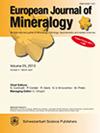Provenance, protolith and metamorphic ages of jadeite-bearing orthogneiss and host paragneiss at Tavagnasco, the Sesia Zone, Lower Aosta Valley, Italy
IF 1.7
3区 地球科学
Q2 MINERALOGY
引用次数: 1
Abstract
Abstract. An eclogite-facies orthogneiss and host paragneiss from a quarry near Tavagnasco in the Lower Aosta Valley were studied in order to refine the protolith, provenance and metamorphic ages of the Eclogitic Micaschist Complex of the Sesia Zone. The orthogneiss contains jadeite with quartz + phengite + K-feldspar ± garnet + rutile + zircon, whereas the paragneiss hosts garnet + jadeite + phengite ± glaucophane + epidote + rutile + quartz. Phase diagram modeling of two representative samples yields minimum equilibration conditions of 550 ± 50 ∘C and 18 ± 2 kbar. Cathodoluminescence images of zircon from the orthogneiss show oscillatory-zoned cores that are embayed and overgrown by complex, oscillatory-zoned rims. Four concordant secondary ion mass spectrometry analyses from the cores give a weighted mean 206Pb / 238U age of 457 ± 5 Ma. The cores have Th/U = 0.1 and negative Eu anomalies indicative of an igneous protolith, which we interpret to have crystallized in the Ordovician at 780 ∘C, based on Ti-in-zircon measurements. Zircon rims yield a range of 206Pb / 238U dates from 74 to 86 Ma, and four concordant analyses define a weighted mean 206Pb / 238U age of 78 ± 2 Ma. The rims are interpreted to have grown in the eclogite facies based on their lower Th/U (0.01), less negative Eu anomalies and steeper heavy rare earth element (HREE) patterns at <600 ∘C. The paragneiss yielded a detrital zircon population with major peaks at 575–600, 655 and 765 Ma; minor older components; and a maximum depositional age of approximately 570 Ma. The prominent Neoproterozoic zircon population and Ediacaran depositional age suggest derivation from the Gondwana margin. The metamorphic zircon is consistent with the oldest eclogite-facies event in the Sesia Zone; it does not show evidence of multiple periods of rim growth or any pre-Alpine (e.g., Variscan) metamorphism.意大利下奥斯塔河谷塞西亚地区塔瓦格纳斯科含硬玉正长岩和寄主副长岩的物源、原岩及变质时代
摘要对下奥斯塔河谷塔瓦格纳斯科附近采石场的榴辉岩相正长岩和寄主副长岩进行了研究,以细化塞西亚带榴辉云母岩杂岩的原岩、物源和变质时代。正长石含硬石+石英+辉长石+钾长石±石榴石+金红石+锆石,副长石含石榴石+硬石+辉长石+绿帘石+金红石+石英。对两个代表性样品的相图建模得出550±50°C和18±2 kbar的最小平衡条件。正长石的阴极发光图像显示振荡带的岩心被复杂的振荡带边缘包围和覆盖。四次离子质谱分析结果一致,表明该岩心的加权平均206pb / 238U年龄为457±5 Ma。这些岩心的Th/U = 0.1和负Eu异常表明是火成岩原岩,根据锆石中的ti值,我们解释这些原岩在奥陶系780°C时结晶。锆石边缘的206Pb / 238U年龄范围为74 ~ 86 Ma, 4个一致性分析确定206Pb / 238U加权平均年龄为78±2 Ma。根据<600°C时较低的th /U(0.01)、较少的负Eu异常和较陡的重稀土元素(HREE)模式,这些边缘被解释为生长于榴辉岩相。副羽岩的碎屑锆石群主要分布在575 ~ 600、655和765 Ma;较小的旧组件;最大沉积年龄约为570 Ma。新元古代突出的锆石群和埃迪卡拉纪的沉积时代表明其起源于冈瓦纳边缘。变质锆石与赛西亚地区最古老的榴辉岩相事件一致;它没有显示出多期边缘生长或任何前阿尔卑斯(例如,瓦里斯坎)变质的证据。
本文章由计算机程序翻译,如有差异,请以英文原文为准。
求助全文
约1分钟内获得全文
求助全文
来源期刊
CiteScore
2.80
自引率
9.50%
发文量
40
审稿时长
6-12 weeks
期刊介绍:
EJM was founded to reach a large audience on an international scale and also for achieving closer cooperation of European countries in the publication of scientific results. The founding societies have set themselves the task of publishing a journal of the highest standard open to all scientists performing mineralogical research in the widest sense of the term, all over the world. Contributions will therefore be published primarily in English.
EJM publishes original papers, review articles and letters dealing with the mineralogical sciences s.l., primarily mineralogy, petrology, geochemistry, crystallography and ore deposits, but also biomineralogy, environmental, applied and technical mineralogy. Nevertheless, papers in any related field, including cultural heritage, will be considered.

 求助内容:
求助内容: 应助结果提醒方式:
应助结果提醒方式:


